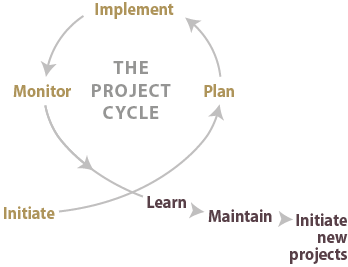ROADSIDE REVEGETATION
An Integrated Approach to Establishing Native Plants and Pollinator Habitat
6.1 Introduction
The goal of roadside revegetation is to establish plant communities along roadsides and other road-related disturbances that meet project objectives1. In practice, however, roadside revegetation projects rarely turn out exactly as planned. Therefore, regular visits to the project site to evaluate progress, and to intervene if necessary, are important parts of the revegetation process.
Monitoring is carried out for two reasons: (1) to correct, manage, and maintain the project effectively and (2) to learn what went right or wrong and apply this knowledge to future projects. Monitoring provides the answers to the following questions:
- Were revegetation goals and expectations met?
- Is native vegetation establishing appropriately or should corrective action be considered?
- Were desired future conditions (DFC) targets met?
- Are there differences in plant responses between different revegetation treatments?
- How are pollinators responding to revegetation treatments?
- Did revegetation result in a plant community capable of supporting a diverse pollinator population?
- Should the revegetation methods and techniques strategy be revised based upon monitoring data?
Answers to these questions may be obtained in a variety of ways depending on the purpose and needs of the project; however, a monitoring plan that can be applied to all revegetation projects does not exist. Instead, a monitoring plan is tailored to the objectives of each project and to the unique characteristics of the site. In developing a monitoring plan, it is important to determine the type and intensity of monitoring in advance. Simple field visits or photo point monitoring over time may provide sufficient information to determine whether objectives have been met, whereas statistically based procedures, outlined in Section 6.3, may help determine if specific targets were achieved. Regardless of the intensity of the strategy, consistency and a long-term commitment are keys to successfully implement an informative monitoring strategy.
Monitoring completes the project cycle by providing feedback regarding the success or failure of a revegetation project. This information can be used to adapt and improve other revegetation projects that are in the initiation, planning, or even implementation phases (Figure 6-1). Information collected during monitoring can help determine if corrective actions, such as adjusting seed mixes or follow-up management activities (e.g., reseeding or replanting), are appropriate. Monitoring results may also be used to improve revegetation techniques for future projects.

Figure 6-1 | Monitoring and the project cycle
Monitoring completes the project cycle and the results are used to guide future management and maintenance work. Monitoring can also provide insights for improving future projects.
The monitoring phase may include the following steps:
- Determining what aspect of the project is to be monitored
- Developing a monitoring plan
- Collecting field data
- Analyzing field data
- Applying corrective measures
- Writing up findings
This chapter begins by describing monitoring plan development and moves through collecting, analyzing, and summarizing data in a monitoring report. A set of procedures are included that outline data collection for different plant, soil, and pollinator attributes.
1 This chapter uses abbreviated scientific names (plant symbols), from the PLANTS Database to conserve space in spreadsheets. The PLANTS Database includes scientific names, plant symbols, common names, distribution data, images, and species characteristics for vascular plants of the United States.

